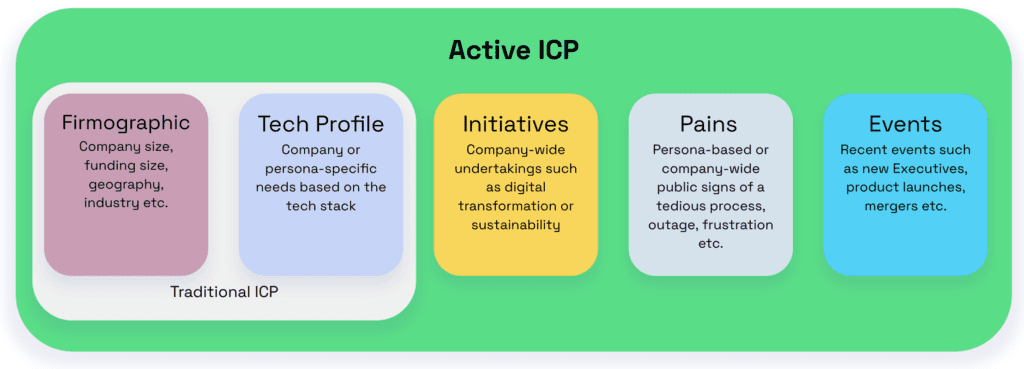The Big A-Ha
B2B companies are struggling to drive efficient growth because they lack a shared, data-driven, and actionable framework for targeting across the Sales and Marketing teams.
Why It Matters
This lack of a targeting framework means that companies struggle to engage and convert their highest-value prospects. This is because they:
- Spread resources across a large set of accounts instead of focusing on a select few,
- Develop campaigns that don’t connect the “why” of the prospect with their value prop, and
- Can’t detect patterns of what’s working and what’s not.
The result is a failure to generate pipeline, close bigger deals, and retain key customers.
An Active ICP definition can help Sales and Marketing teams focus their resources, develop compelling campaigns, and scale the patterns needed to drive efficient growth.
Go Deeper: What is Active ICP?
Traditional ICP definitions are based solely on company firmographic and technographic data. The Active ICP includes these attributes but goes beyond them to include context on the prospect’s motivations and the current situation.

This context is a measure of the company characteristics that make a prospect a great fit for your solution right now. Developing an understanding of these signals gives you critical information about the “why” of a prospective company. This is what you can then use to develop targeted Marketing and Sales campaigns to drive efficient growth.
Active ICP in Action: Driving Efficient Growth
The Active ICP is designed to be actionable. It promotes alignment between Sales and Marketing by building trust, facilitating a more efficient allocation of resources, and aligning the teams on the areas of highest opportunity. Let’s take a deeper look:

- Target Accounts: The Active ICP enables the Sales and Marketing teams to work together in identifying target accounts that are the best fit for their Product. Teams can coordinate their efforts on the same strategic accounts and avoid wasting time on poor-fit prospects. They can segment accounts into tiers and specific plays to run synchronized account-based strategies. This is the essential first step in executing an ABM/ABX motion and it ensures that Sales and Marketing are committed to a shared definition of success from the beginning.
- Tailored Campaigns: The Active ICP segments provide essential “Why” context that helps teams connect the prospect’s needs, pains, and initiatives to how their solution can help. This helps Sales and Marketing teams to develop content, messaging, campaigns, and plays tailored to resonate with the relevant personas at target accounts.
- Buyer Experience: The Active ICP provides a framework for Sales and Marketing to optimize the prospect experience across the buying journey. They can design an orchestrated set of hand-offs, service level agreements, shared metrics, reviews, campaigns, content offers, and outreach approaches based on what will most resonate with ICP accounts.
- Data-Driven Optimization: An ICP provides the focal point for Sales and Marketing to continually review performance, assess what’s working well, identify areas for improvement, and collaborate to make optimizations. Teams can evaluate the impact of campaigns, content, outreach, and other initiatives on Active ICP accounts to determine how to improve them for greater impact.
- Growing Trust: Developing an ICP requires Sales and Marketing to share data and insights on their customers, lost opportunities, and highest-value accounts. This sharing of knowledge and perspectives helps strengthen understanding, builds alignment, and benefits future planning. With an Active ICP, Sales and Marketing teams can establish shared goals, KPIs, and metrics for ideal account acquisition, pipeline, retention, spending, and ROI. They hold one another accountable for quantifiable results and work as partners to achieve those goals.
Next Steps: Develop Your Active ICP
Do you know your Active ICP? Drop me a note here and we can do a session to help you and your team focus on your highest-value prospects.
